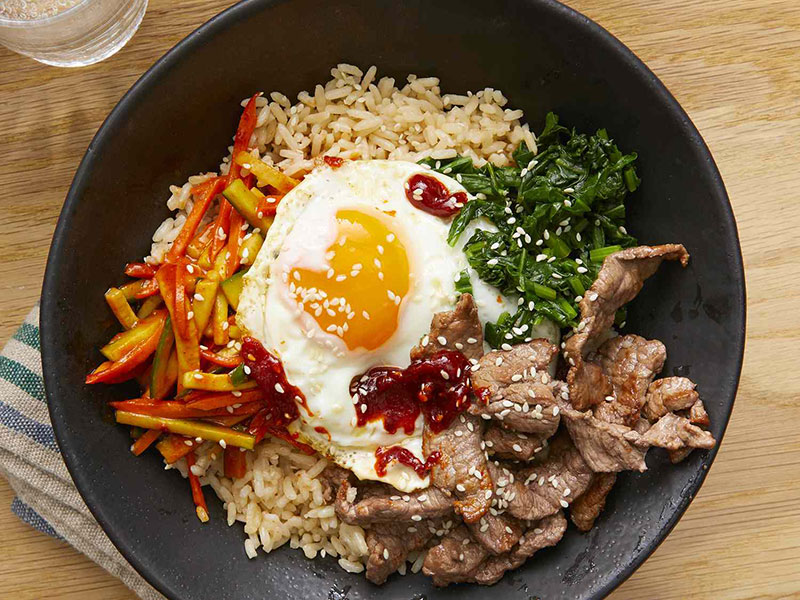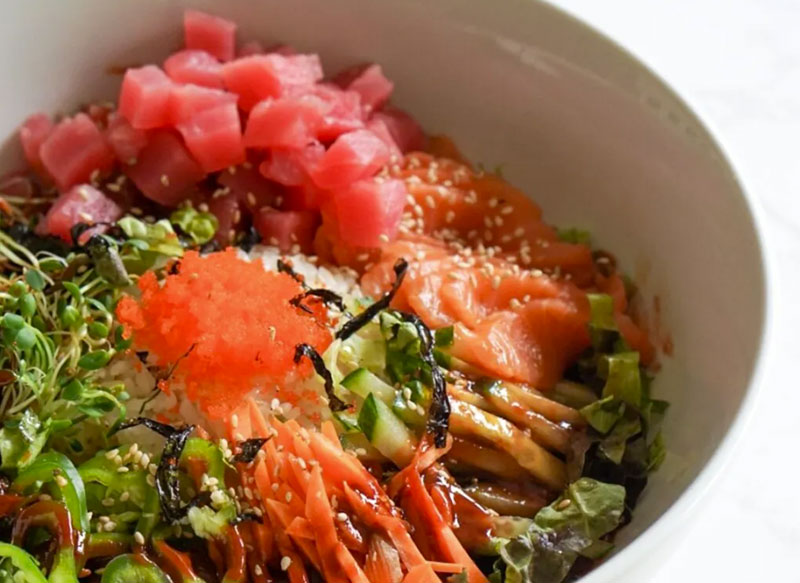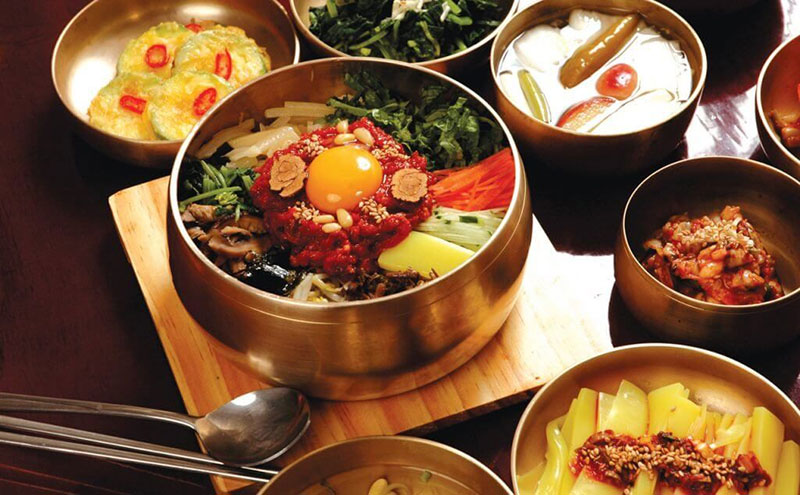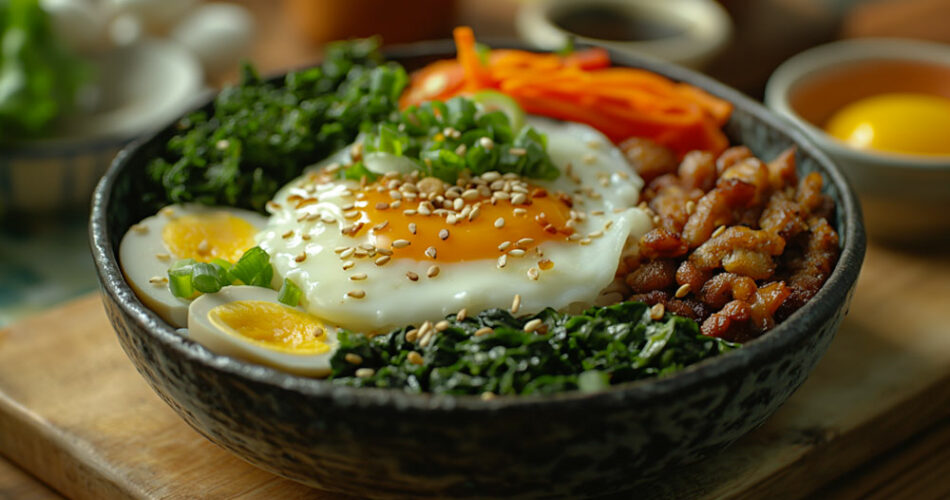Imagine this: a sizzling hot stone bowl arrives at your table, its contents, a vibrant tapestry of colors and textures, practically dancing in the heat. Each scoop is a harmony of flavors, a culinary ode to balance and nutrition. Welcome to the world of bibimbap recipes, Korea’s ultimate comfort food and your next cooking conquest.
As a fervent home chef with a penchant for Korean cuisine, I’ve spent the better part of fifteen years perfecting the art of this beloved dish. And now, it’s your turn to master the mix.
By the end of this delve into the delicious, you’ll have unraveled the secrets to crafting the perfect bibimbap. We’ll explore everything from selecting the right rice dish variations to the precise layering of namul and the zesty kick of gochujang sauce.
Structured like a mosaic of tastes, our journey will take you through the foundations of traditional Korean cuisine, recipe twists for the modern palate, and tips for capturing that signature stone bowl cooking magic right at home. Let’s begin our culinary adventure, where each stir is a step into a grand realm of flavors.
Bibimbap Recipes
| Bibimbap Variety | Main Ingredients | Distinctive Feature | Serving Style | Region/Origin |
|---|---|---|---|---|
| Traditional Bibimbap | Mixed vegetables, gochujang, sesame oil, beef, fried egg | Combination of warm rice with assorted mix-ins, usually with seasoned vegetables and a spicy sauce | Served in a regular bowl | Throughout Korea |
| Dolsot Bibimbap | Same as traditional, plus occasional raw egg yolk | Served in a hot stone pot (dolsot) which creates a crispy rice crust at the bottom | Served in a hot stone bowl (dolsot) | Throughout Korea |
| Hwe Bibimbap | Raw fish in place of meat, mixed vegetables, gochujang or soy sauce based sauce | Seafood variation featuring sashimi-style fish | Served chilled in a regular bowl | Coastal areas |
| Namul Bibimbap | Variety of seasoned vegetables (namul), gochujang, sesame oil, optional meat | Focus on the seasoned vegetables (namul). Can be made without meat for a vegetarian option. | Served in a regular bowl | Throughout Korea |
| Jeonju Bibimbap | Bean sprouts, jeon (fried egg with other ingredients), beef tartare, gingko nuts, pine nuts | Famous for its richness and the variety of ingredients, considered the most authentic | Served in a regular bowl | Jeonju City |
| Vegetarian or Vegan Bibimbap | Vegetables, tofu as a protein substitute, no animal products | Excludes meat, eggs, and other animal products; uses plant-based ingredients | Served in a regular or stone bowl | Throughout Korea |
Traditional Bibimbap

Image source: allrecipes
Description: The Traditional Bibimbap is the quintessence of Korean mixed rice dishes. A vibrant array of namul, or seasoned vegetables, crowns steamed white rice, accompanied by slivers of marinated beef. Topped with a glistening sunny-side-up egg and adorned with a swirl of spicy gochujang sauce, each ingredient is a note in a symphony of flavors, waiting to be stirred together.
What we like about it: It’s the ultimate introduction to bibimbap recipes, encompassing all the classic elements and flavors that have made this dish a cornerstone of Korean cuisine.
Dolsot Bibimbap

Description: Dolsot Bibimbap transforms the basic into the exceptional. Served in a pre-heated stone bowl, this version guarantees a delectable crust of scorched rice at the bottom. The sizzle as the rice hits the hot dolsot is music, promising a toasty complexity beneath the fresh, colorful veggies and succulent beef.
What we like about it: That irresistible crunch of rice sets the Dolsot Bibimbap apart, upgrading the textural experience in a way that’s uniquely satisfying.
Hwe Bibimbap

Image source: Teek eatz
Description: Hwe Bibimbap is a delightful variant that beckons the sea to your bowl. Instead of cooked meats, vibrant sashimi-grade fish slices lay atop the usual suspects of warm rice and vegetables. Often served with a spicy, sweet and sour gochujang sauce, it’s a refreshing spin that marries the ocean’s bounty with hearty Korean staples.
What we like about it: The fresh sashimi adds a light, clean taste, balancing the boldness of the traditional bibimbap ingredients with delicate subtlety.
Namul Bibimbap

Description: A celebration of garden’s variety, Namul Bibimbap puts vegetable sides front and center. Diverse namul stretch across the bowl, each bringing its unique seasoning and charm. This feast of flavors is not just a treat for the tongue but a vibrant visual delight, reflecting the natural beauty of the ingredients.
What we like about it: This dish shines the spotlight on the hearty and healthful universe of Korean seasoned vegetables, making it a nutritious choice that doesn’t skimp on taste.
Jeonju Bibimbap

Image source: Jeonju City
Description: Hailing from the city considered the food capital of Korea, Jeonju Bibimbap is a luxurious variant, rich in history and taste. Often incorporating over 30 ingredients, including unique items like raw beef and yellow mung bean jelly, it’s a complex ensemble that tells a story in every bite.
What we like about it: The diversity of ingredients in Jeonju Bibimbap offers an unmatched depth of flavor, a true celebration of traditional Korean ingredients.
Vegetarian or Vegan Bibimbap

Description: Flexibility is the charm of Vegetarian or Vegan Bibimbap, where every element is plant-based. It’s as bright and flavorful as its meaty counterparts, with tofu often stepping in as the protein star. The array of vegetables and the absence of animal products make it as wholesome as it is delicious.
What we like about it: This version is perfect for those leading a plant-based lifestyle, ensuring that the joy of bibimbap can be shared by all.
FAQ on Bibimbap Recipes
What ingredients are essential for making traditional bibimbap?
Every bowl of bibimbap calls for a foundation of steamed rice, a medley of namul (sautéed vegetables), slices of beef, a raw or fried egg, and a dollop of spicy gochujang sauce. These essentials set the stage for a classic Korean culinary experience.
How do I achieve the perfect crispy rice in a dolsot bibimbap?
To ensure that signature stone bowl crunch, coat the dolsot with sesame oil and preheat until it’s piping hot. Add cooked rice and let it sizzle untouched, allowing a golden crust to form, which is the hallmark of dolsot bibimbap.
Can bibimbap be made vegetarian or vegan-friendly?
Absolutely, bibimbap is incredibly adaptable. Swap out the beef for tofu or just go heavy on the vegetable toppings. Omit the egg or use an egg substitute. With Korean mixed rice, it’s all about balance and personal preference.
What’s the best way to incorporate protein into bibimbap if I don’t eat beef?
Feel free to get creative! Chicken, shrimp, or any kind of legume can stand in for beef. Tofu is a popular option, especially when marinated and pan-seared. It’s about weaving in proteins that you enjoy into your bibimbap recipes.
Is it necessary to serve bibimbap in a hot stone bowl?
While a hot stone bowl, or dolsot, creates a tantalizing crust, it’s not a must. A regular bowl does just fine for serving bibimbap. The heart of this dish lies in its mixed textures and flavors, not the vessel it’s served in.
What type of rice works best for bibimbap?
Short-grain white rice, often used in Korean cooking, is ideal for bibimbap recipes. It sticks together just enough to make the perfect scoop with all the goodies piled on top.
How do I make gochujang sauce for bibimbap?
Mix gochujang (red chili paste) with sesame oil, sugar, and a splash of soy sauce or water to reach a smooth, drizzle-friendly consistency. Some recipes include garlic or apple cider vinegar for extra zing in your bibimbap.
How can I add more flavor to bibimbap?
A little goes a long way with bibimbap. Each element brings its own unique note—sesame oil enhances the base, a mix of sautéed vegetables adds depth, and the spicy gochujang sauce unifies every bite with a punch of bold flavor.
Is bibimbap considered a healthy meal?
Yes, bibimbap ranks high on the nutrition scale. It’s a balanced combo of vegetables, carbs, and protein. Plus, you’re in the driver’s seat when it comes to portion control and ingredients—go heavy on the veggies and lean on the sauce to suit your dietary needs.
How do I properly mix bibimbap before eating?
There’s an art to the mix—stir everything thoroughly with a spoon, ensuring every bite includes a bit of rice, protein, egg, vegetables, and gochujang sauce. The joy of bibimbap lies in tasting the harmony of all its components.
Conclusion
Wrapping things up, we’ve journeyed through the vibrant world of bibimbap recipes, a staple of Korean cuisine known for its harmony and color.
- We’ve seen how this dish flexibly accommodates every eater, whether you’re crafting a vegetarian bowl or one packed with protein options like tofu or chicken.
- We’ve talked about achieving that elusive rice dish crunch without a hot stone bowl, proving that bibimbap doesn’t shackle you to tradition—it invites innovation.
- We’ve stirred in gochujang sauce for an unbeatable kick and tossed in fresh, bright vegetable toppings for a feast as nutritious as it is delicious.
Hold these tips close to your apron. With them, you’re more than ready to create your own bibimbap—healthy Korean meals that don’t just nourish the body but delight the senses. Now, pick up that spoon, and let the mixing begin—it’s time to taste the journey you’ve been on, one vibrant scoop after another.

